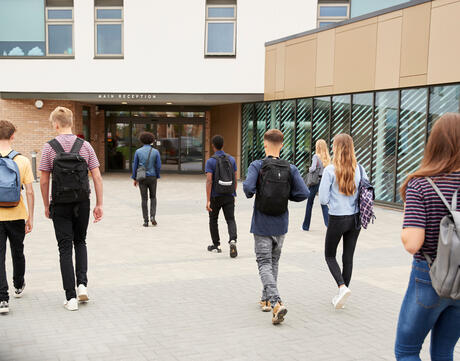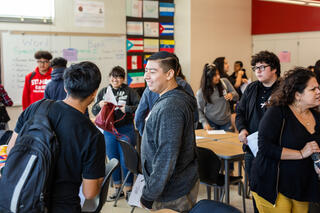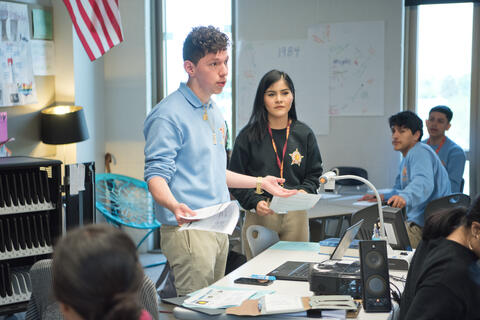
Building Belonging with New Classroom Activities for Back to School
The beginning of the school year is an exciting time that represents a fresh start for students and teachers.
Even amid pressures to jump right into academic instruction, it’s crucial to take time at the start of the year to build connections, create community, and lay the foundation for building a classroom where everyone feels they belong. With this in mind, we’re excited to share our Back-to-School Toolkit, which offers some special updates and new activities this year. Whether this is the first time you’re using it, or it’s a regular part of your back to school routine, we hope these resources help you and your students co-create brave, trust-filled classrooms this year.
New “Welcome Back” and Contracting Activities
Our updated Back to School Toolkit also includes two new activities to welcome students back into your classroom. In Building Connections with Concentric Circles, students share small details about themselves (such as their favorite foods and places they’d like to travel) using the “concentric circles” discussion strategy. Through this activity, students experience a deepened sense of belonging as they discover connections between themselves and their classmates.

Back to School: Building Community for Connection and Learning
Additionally, we’ve added a goal-setting activity to orient students towards a new school year. Research demonstrates that when students are provided with instructional time to set personal goals, they demonstrate higher academic achievement and engagement in the classroom. 1 In Create a Goal and Discover Your “Why”, students create a personal goal and uncover their intrinsic motivation, a source of motivation that research has found to be more durable than extrinsic factors. By the end of the activity, they will have a strong understanding about why their goal matters to them as well as actionable steps they can take toward accomplishing their goal.
Finally, we’ve updated our activity on classroom contracting with a new protocol designed with the beginning of the school year in mind. Contracting is the process of openly discussing with your students’ expectations for how classroom members will treat each other to foster an inclusive class culture. Contracting for Back to School asks students to reflect on their experiences learning in classrooms where they felt welcome and classrooms where they didn’t feel welcome. Students use these reflections to brainstorm community norms that prioritize mutual respect. By the end of this activity, your class will have a contract that lays the foundation for a learning environment where all students are more likely to feel seen and heard.
Plus, Activities for Getting to Know Each Other
While the first days of school can be fun, they can also raise cortisol levels, the hormone responsible for stress and anxiety. This is especially true for students transitioning to a new school or starting school in a new country.
For Ka’Isis Lee, a secondary school student whose essay Is it Kay? is featured in our updated Back to School Toolkit, the most anxiety-inducing part of the first day of school was the roll call. Lee writes:
I’ve always dreaded the first day of school simply because I knew that in every classroom I entered, the teacher inside would reach a certain point on the student list where the last names that begin with K and L met. I would know exactly when they got to that point because of their hesitation and the resulting dead silence in the room… No, it doesn’t help that I have social anxiety…no it doesn’t help that I’m a person of color…and it definitely doesn’t help that I have a naturally quiet voice.
Lee’s experience demonstrates the importance of learning and pronouncing names correctly at the beginning of the school year. As Henry David Thoreau once observed:
- 1D. A. Rowe, V. L. Mazzotti, A. Ingram, and S. Lee, “Effects of Goal-Setting Instruction on Academic Engagement for Students At Risk,” Career Development and Transition for Exceptional Individuals 40, Issue 1 (2017): 25–35.
When we take the time to learn each other’s name, we are building bridges that allow us to share our ideas and our identities.
In the activity Pronouncing Names, a new addition to our updated Back to School Toolkit, students examine the significance of pronouncing a person’s name correctly and learn the names of their classmates. By the end of the activity, students will understand that learning and correctly pronouncing each other’s name creates a welcoming environment where everyone feels valued and included.
At Facing History & Ourselves we believe that teachers and students benefit from classrooms that nurture community, build relationships, and attend to students’ social-emotional needs. In these classrooms, students become empowered to engage with the content, take risks, and support one another. Whether the 2023-24 school year is your first year in the classroom or your twentieth year, we thank you for the work you do. Happy New School Year!

Pronouncing Names
Help students examine the significance of pronouncing a person’s name correctly.

